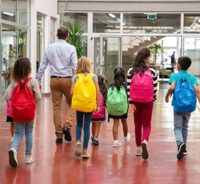
As the pandemic stretches into year three, one must ask: What happens when an emergency is no longer emergent? Many school and district leaders rapidly adapted and stretched to make the best of challenging times. Despite these efforts, districts are facing escalating levels of stress. In an environment characterized by both real and manufactured controversies, many frontline educators are feeling undervalued and pushed to their limits. As a result, many leaders are recognizing that their districts cannot wait for a post-pandemic period to regroup around their educational mission.
Amidst both health-related and political disruptions, leaders are looking for creative ways to keep the focus on student learning and instructional impact. The COVID-19 pandemic, for all its devastation, has opened an opportunity for schools and districts to transition into a new era. The past two years have highlighted existing systemic inequality in the U.S., and brought increased urgency to addressing how and for whom schools work. The education field, like many others, needs to recognize and seize this moment as one to move forward and rethink the traditional.
The Biden Administration is providing new funds and flexibility to states and districts which, when used wisely, have the potential to catalyze innovation. These resources are short-term, presenting districts with a choice. They can continue to spend heavily to overrun schools with trendy programs and short-term hires—nearly all of which will be gone in three years. Or, by recalibrating this winter, districts can make mid-course improvements that are responsive to staff, students and their families. Addressing the sustained challenges of the pandemic and the widening inequality it is producing requires creativity from the field. Here is what that might look like:
Draw on the lessons of the recent past.
An essential lesson is that the pandemic is catalyzing many educators and families to help students learn in innovative ways. Teachers are acquiring new technology and presentation skills to incorporate into their in-school and online classrooms. School districts are developing virtual methods of delivering and tailoring professional development to their teachers. Families are becoming more experienced in supporting learning at home. Districts should convene educators, students, and community members to identify the full range of promising strategies that are making a difference for students and should be sustained moving forward.
Maintain detailed, nuanced data on what students can do.
The key to new learning is to build on student strengths. But teachers must know those strengths before they can build upon them. Teachers need to listen to students in new ways, gathering data on the ground-level to meet their mental, physical, and academic needs. Schools that provide teachers with the support and structures to formalize check-ins with students will take pressure off their teachers and gain a better understanding of the progress of their students. The era of relying primarily on high-stakes annual tests to gauge individual student progress needs to be reconsidered. What data we collect now has to help teams of teachers tailor their instructional strategies to respond to a broader range of individual student needs.
Leverage STEM to advance learning and equity.
The pandemic impacted marginalized communities disproportionately, exacerbating pre-existing divisions and achievement gaps in schools. The new federal resources provide districts with an opportunity to take a creative approach to engaging all students in accelerated learning. Integrating STEM across the core subjects of the curriculum, as they have done in the Tracy Unified School District in California, ensures that all students have rigorous, content-rich learning opportunities. There, STEM instruction starts before kindergarten and extends through high school. This kind of curricular and instructional innovation accelerates both learning and equity.
Recalibrate continually.
Districts need not wait for this school year to end to think creatively about how schooling will look going forward. They can refocus their plans based on evidence of both student progress and continuing needs as they become visible. There is a strong desire for districts to return to pre-pandemic normalcy. Yet well-managed and responsive change can be even more reassuring to communities. The goal is to educate children effectively, and our nation was falling short of doing so before the pandemic.
The pathway laid out here guides school districts in recasting how to make learning come alive for students. The pandemic has underscored both the existing inequities of the education system and the creativity and innovation the education field is capable of achieving. Educating students amidst changing circumstances is always the job of a school district. Now is the time for leaders to demonstrate urgency in transforming how and for whom schools work.
